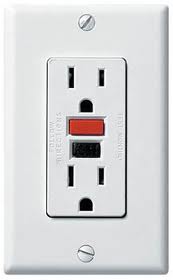
One of the most common service calls we receive is a problem that can often be resolved by the simple push of a button. If you’re experiencing one of the above problems, you may have what is known as a “tripped” GFCI receptacle.
Since the 1970’s, the National Electrical Code has required that any receptacle (a.k.a. “plug” or “outlet”) with the potential to be near water must be GFCI protected. A GFCI (ground fault circuit interrupter) is particularly sensitive to the slightest fault (or short) to ground and will open (or break) the circuit before a standard circuit breaker will. It was designed as a safety precaution that instantly opens the circuit to prevent a person from being electrocuted while in contact with water. As a result of the increased sensitivity of these devices, they occasionally open the circuit (or “trip”) at other times. This commonly happens when they are exposed to unusual amounts of moisture, or during electrical storms or severe power surges.
Many people are not aware that some normal receptacles may be protected by a GFCI receptacle somewhere farther “upstream” in the circuit. If you are experiencing one of the above mentioned problems, before you pay an electrician for a service call, you may want to try the following solutions.
If some of your kitchen plugs are not working, look all around the counter top and along the kitchen and dining room walls for a GFCI receptacle (see image above). Be sure you look behind all the small appliances. If you find one, make sure the “reset” (top) button is pressed in. If the GFCI receptacle is working properly, pushing the “test” (bottom) button will cause the top button to pop out. You should hear a sharp “click” upon pressing the test button. After you have pressed the reset button, check to see if all your kitchen plugs are now working. Be aware, most kitchens have two separate GFCI receptacles that protect a number of other plugs in the kitchen.
If some of your bathroom plugs or lights are not working, look through each bathroom in the house for GFCI receptacles. Follow the directions in the paragraph above for testing and resetting a GFCI. Realize, each bathroom may have its own GFCI receptacle, or multiple bathrooms may be protected by just one GFCI receptacle.
If your outside plugs aren’t working, check each outside plug, garage plug or basement plug for a “tripped” GFCI receptacle. If you have a house built before 1980, you may even want to check your bathroom receptacles.
If your garage plugs are not working, look all around the interior of the garage for a “tripped” GFCI receptacle.
If your basement plugs or lights are not working look all around e basement for a “tripped” GFCI receptacle.
If your GFCI receptacle will not reset, or you’ve tried everything mentioned above and your plugs still don’t work, unplug any appliance or device that is plugged into the non-working receptacles and try resetting the GFCI again. If it resets, you may have a problem with whatever appliance was plugged in. If it still doesn’t reset, you may have a tripped circuit breaker. See our article on how to properly reset a “tripped” circuit breaker. If this still doesn’t resolve the problem, it’s time to call an electrician.
